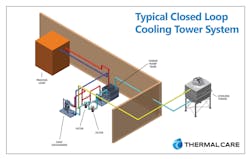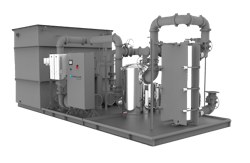Cooling tower system temperature control: A study in multiple stages of temperature control
Cooling tower systems are an extremely effective method of process cooling. Changing the state of water from liquid to gas through evaporation absorbs significant amounts of energy, known as the latent heat of vaporization. This energy transfers from the water in the process stream that does not evaporate and results in a lower water temperature.
Many factors determine how much energy a cooling tower can remove from a system. These include the water flow rate and entering temperature, the spray pattern inside the tower and the available surface area for evaporation, the airflow through the tower and the ambient conditions — including temperature and humidity — (expressed as wet-bulb temperature).
With so many factors influencing the amount of energy the tower can remove, the tower’s cooling capacity will fluctuate as these parameters change. Therefore, the outlet water temperature from the tower varies as well.
In this article, we will review the design of a cooling tower system that Thermal Care recently designed and built. The purpose of the review is to illustrate a few concepts that improve the precision of the outlet water temperature control. While these concepts are part of a specialized system, each are implemented independently on common tower system designs as well. These concepts provide multiple stages of temperature control/capacity control to help the tower system maintain setpoint. Additionally, these control methods help the system react to changing cooling demands more quickly.
The example cooling tower system is a closed-loop design. A closed-loop design isolates the cooling tower water from the process water loop through a heat exchanger. This type of system design protects the process equipment from the potential contaminants and corrosion associated with open loop tower systems.
While there are concessions associated with a closed-loop tower system, such as lost efficiency because of the temperature differential through the heat exchanger, there are also benefits. The primary benefit is the clean process water loop as mentioned earlier, but the introduction of the heat exchanger provides an opportunity to include a 3-way temperature control circuit.
This circuit consists of a 3-way modulating valve, control programming and a temperature sensor. The temperature sensor is installed on the “to process” outlet connection of the heat exchanger. The sensor’s reading represents the temperature of the water delivered to the process with the goal of matching the setpoint.
The 3-way modulating valve mounts on the cooling tower side of the heat exchanger and provides a bypass line directly from the heat exchanger inlet to the outlet (bypassing the heat exchanger). The temperature sensor provides feedback to the controller that compares it to the setpoint input by the user. Based upon this comparison, the 3-way valve will modulate the amount of cooling tower water directed through the heat exchanger and increase or decrease the effective cooling. This delivers finer control of the temperature delivered to the process. Temperature control accuracy using this design can deliver up to +/- 1°F stability.
Implementing a VFD, or variable frequency drive, for the cooling tower fan motor is another method to improve temperature control. Traditional cooling tower fan control logic staged the fan motor on (full speed) or off based upon the setpoint of the system. Often, this was too coarse of an adjustment and resulted in wide temperature swings.
With a VFD, the system will still stage the fan on when required, but it will stage on at a reduced speed. This speed is based on the VFD’s minimum allowable speed, typically 20-30% of full speed. The VFD receives temperature feedback from a sensor mounted in the tower’s outlet piping. Once the fan motor is on and running at the minimum speed, the VFD will continue to increase the fan speed while the temperature feedback remains above the setpoint. Once achieving the setpoint, the VFD will hold the current speed.
In the example Thermal Care system, there were three cooling towers. Including a VFD with each cooling tower fan motor enables an additional level of control. Each fan stages on individually at the minimum speed. Then, once all fans are on, at minimum speed, the controller manages the group of fans as a single entity ramping the speed up and down as required to maintain setpoint. This control method ensures the load distributes between all the towers as well as maximizes energy efficiency by keeping each fan speed at the lowest requirement for the system.
Finally, an important method of temperature control for a closed-loop cooling tower system relates to its freeze protection. By design, the cooling tower side of the closed loop system must maintain flow at all times. Even when bypassing the heat exchanger using the temperature control circuit discussed above, the flow through the system continues.
This presents a dilemma during cold ambient conditions. There exists a scenario where the required cooling is at a minimum or even zero, but because flow maintains through the system, the cooling tower water is still pumping outside. The temperature of the system will continue to drop even if the fans have turned off. The cooling is purely coming from the ambient temperatures, and this is when freezing can occur.
To protect against this scenario, installing a 3-way diverting valve will protect the system. The user can input a minimum allowable temperature for the system. Using the diverting valve installed in the cooling tower supply line, the 3-way diverting valve will direct the water away from the towers and directly back into the reservoir to maintain the temperature above the set minimum.
Employing each of these temperature control strategies together or independently will have a significant impact on the ability of your cooling tower system to maintain the desired setpoint.
Tom Stone is national sales manager, industrial markets for Thermal Care. He has 14 years of experience in designing and applying process cooling solutions and has a degree in Mechanical Engineering from Purdue University.
Thermal Care




